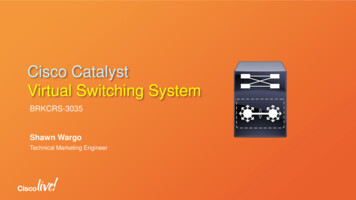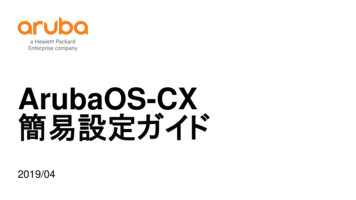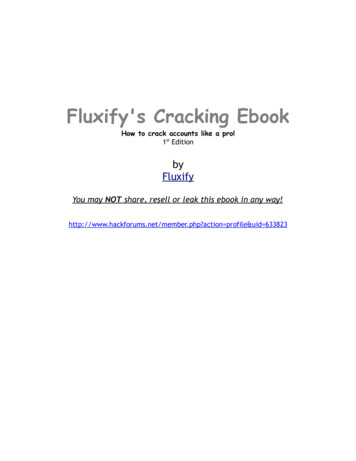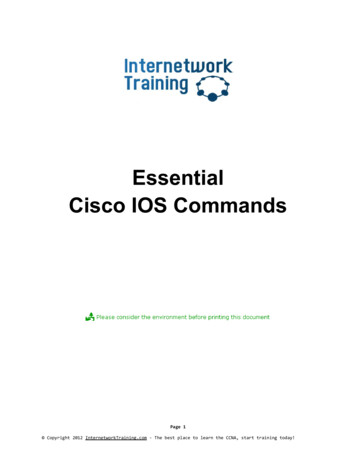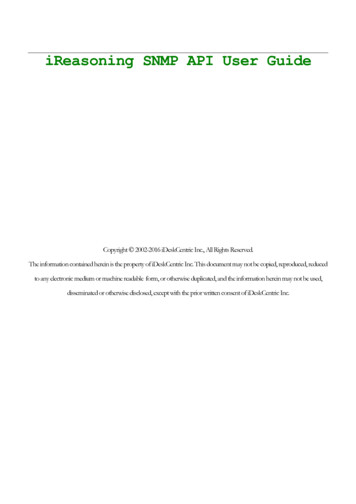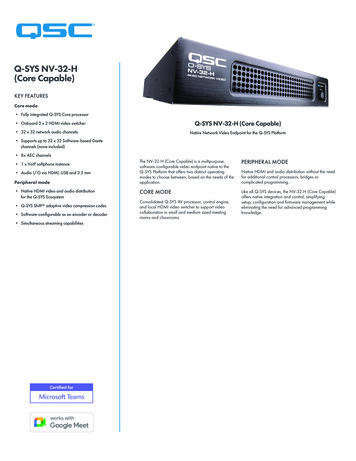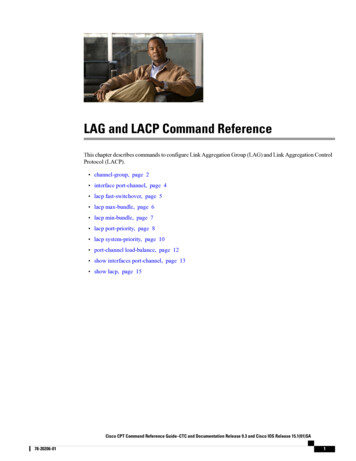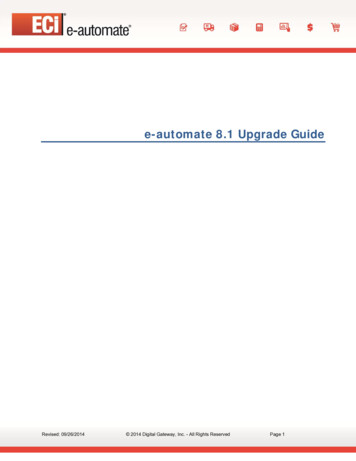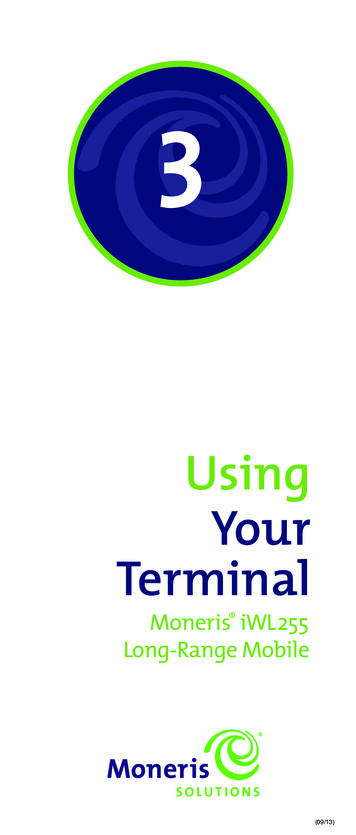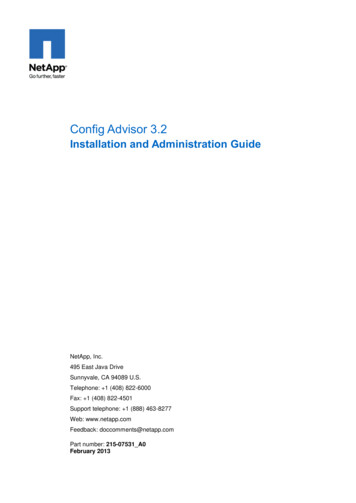
Transcription
Config Advisor 3.2Installation and Administration GuideNetApp, Inc.495 East Java DriveSunnyvale, CA 94089 U.S.Telephone: 1 (408) 822-6000Fax: 1 (408) 822-4501Support telephone: 1 (888) 463-8277Web: www.netapp.comFeedback: doccomments@netapp.comPart number: 215-07531 A0February 2013
Copyright InformationCopyright 1994–2013 NetApp, Inc. All rights reserved. Printed in the U.SNo part of this document covered by copyright may be reproduced in any form or by any means—graphic,electronic, or mechanical, including photocopying, recording, taping, or storage in an electronic retrievalsystem—without prior written permission of the copyright owner.Software derived from copyrighted NetApp material is subject to the following license and disclaimer:THIS SOFTWARE IS PROVIDED BY NETAPP "AS IS" AND WITHOUT ANY EXPRESS OR IMPLIEDWARRANTIES, INCLUDING, BUT NOT LIMITED TO, THE IMPLIED WARRANTIES OF MERCHANTABILITYAND FITNESS FOR A PARTICULAR PURPOSE, WHICH ARE HEREBY DISCLAIMED. IN NO EVENTSHALL NETAPP BE LIABLE FOR ANY DIRECT, INDIRECT, INCIDENTAL, SPECIAL, EXEMPLARY, ORCONSEQUENTIAL DAMAGES (INCLUDING, BUT NOT LIMITED TO, PROCUREMENT OF SUBSTITUTEGOODS OR SERVICES; LOSS OF USE, DATA, OR PROFITS; OR BUSINESS INTERRUPTION)HOWEVER CAUSED AND ON ANY THEORY OF LIABILITY, WHETHER IN CONTRACT, STRICTLIABILITY, OR TORT (INCLUDING NEGLIGENCE OR OTHERWISE) ARISING IN ANY WAY OUT OF THEUSE OF THIS SOFTWARE, EVEN IF ADVISED OF THE POSSIBILITY OF SUCH DAMAGE.NetApp reserves the right to change any products described herein at any time, and without notice. NetAppassumes no responsibility or liability arising from the use of products described herein, except as expresslyagreed to in writing by NetApp. The use or purchase of this product does not convey a license under anypatent rights, trademark rights, or any other intellectual property rights of NetApp.The product described in this manual may be protected by one or more U.S. patents, foreign patents, orpending applications.RESTRICTED RIGHTS LEGEND: Use, duplication, or disclosure by the government is subject to restrictionsas set forth in subparagraph (c)(1)(ii) of the Rights in Technical Data and Computer Software clause atDFARS 252.277-7103 (October 1988) and FAR 52-227-19 (June 1987).Trademark InformationNetApp, the NetApp logo, Network Appliance, the Network Appliance logo, Akorri, ApplianceWatch, ASUP,AutoSupport, BalancePoint, BalancePoint Predictor, Bycast, Campaign Express, ComplianceClock,Cryptainer, CryptoShred, Data ONTAP, DataFabric, DataFort, Decru, Decru DataFort, DenseStak, Engenio,Engenio logo, E-Stack, FAServer, FastStak, FilerView, FlexCache, FlexClone, FlexPod, FlexScale,FlexShare, FlexSuite, FlexVol, FPolicy, GetSuccessful, gFiler, Go further, faster, Imagine Virtually Anything,Lifetime Key Management, LockVault, Manage ONTAP, MetroCluster, MultiStore, NearStore, NetCache,NOW (NetApp on the Web), Onaro, OnCommand, ONTAPI, OpenKey, PerformanceStak, RAID-DP,ReplicatorX, SANscreen, SANshare, SANtricity, SecureAdmin, SecureShare, Select, Service Builder, ShadowTape, Simplicity, Simulate ONTAP, SnapCopy, SnapDirector, SnapDrive, SnapFilter, SnapIntegrator,SnapLock, SnapManager, SnapMigrator, SnapMirror, SnapMover, SnapProtect, SnapRestore, Snapshot,SnapSuite, SnapValidator, SnapVault, StorageGRID, StoreVault, the StoreVault logo, SyncMirror, TechOnTap, The evolution of storage, Topio, vFiler, VFM, Virtual File Manager, VPolicy, WAFL, Web Filer, andXBB are trademarks or registered trademarks of NetApp, Inc. in the United States, other countries, or both.Apple is a registered trademark and QuickTime is a trademark of Apple, Inc. in the United States and/or othercountries. Microsoft is a registered trademark and Windows Media is a trademark of Microsoft Corporation inthe United States and/or other countries. RealAudio, RealNetworks, RealPlayer, RealSystem, RealText, andRealVideo are registered trademarks and RealMedia, RealProxy, and SureStream are trademarks ofRealNetworks, Inc. in the United States and/or other countries.All other brands or products are trademarks or registered trademarks of their respective holders and shouldbe treated as such.NetApp, Inc. is a licensee of the CompactFlash and CF Logo trademarks.NetApp, Inc. NetCache is certified RealSystem compatible.
Table of .4.48.58.5.18.5.28.68.6.18.799.1INTRODUCTION TO CONFIG ADVISOR . 7What Config Advisor is . 7Features in Config Advisor . 8Configurations supported by Config Advisor . 8INSTALLING, CONFIGURING, UPGRADING, AND UNINSTALLING CONFIG ADVISOR . 10Installing Config Advisor . 10Configuring Config Advisor . 10Upgrading Config Advisor. 11Uninstalling Config Advisor . 11COLLECTING DATA . 12Collecting data from a Data ONTAP 7 and 8 (7-Mode) installation . 12Collecting data by using the Network tab . 12Collecting data by using the Serial Port tab . 14Collecting data by using the AutoSupport (by ASUP Id) tab . 17Collecting data by using the AutoSupport (from file) tab . 19Collecting data by using the batch data collection mode . 20Collecting data from clustered Data ONTAP . 21Collecting data by using the Network tab . 21Collecting data for FlexPod setup . 23WORKING WITH RESULTS. 26Recent Results pane . 26Viewing results . 26What Config Advisor Viewer does . 27Viewing 7-Mode results in Config Advisor. 28Controllers pane . 29Viewing clustered Data ONTAP results in Config Advisor . 31Nodes pane . 32Cluster Switches pane . 32Management Switches pane . 33Viewing FlexPod results in Config Advisor . 33Navigation pane . 34Configuration Validations and Health Checks pane . 37Generating a PDF report . 38Generating an MS Excel report . 38Generating a MS Word report . 39WORKING WITH CREDENTIALS . 40Saving credentials . 40Saving a query. 41SETTING PREFERENCES IN CONFIG ADVISOR . 42Enabling Config Advisor AutoSupport . 42What Config Advisor AutoSupport is . 42What FTP Metrics are. 43Sample of an FTP Metrics file . 43Enabling or disabling Config Advisor Logs pane . 44What Config Advisor Logs pane is . 44REPORTING ISSUES IN CONFIG ADVISOR . 45USING CONFIG ADVISOR IN SECURE SITES . 46What Data Collector and Sanitizer script is . 46Prerequisites for using the Data Collector and Sanitizer script. 46Installing PowerShell 2.0. 46Installing Data ONTAP PowerShell toolkit 2.0 . 47Running the script . 48Data collection methods for secure sites . 49Interactive data collection method . 49Batch-mode data collection method . 50Command-line argument method . 51Collecting data manually . 53Filtering and mapping . 56Collecting and filtering data. 56Filtering precollected data . 57Analyzing filtered data file . 59Importing filtered data file for analysis. 59Launching Help for the script . 60TROUBLESHOOTING . 61Nx50xx with 5.2.x displays multiple firmware related error messages . 61Config Advisor 3.2 Installation and Administration Guide3 of 75
9.29.39.49.5A.Stack Same Card and Stack Same Bridge messages displayed . 61Entering AutoSupport ID in the old format displays an error message . 62Cabling faults not identified for FC and SATA shelves . 63Format of the text file for the AutoSupport (from file) tab . 63APPENDIX: CONFIGURATION VALIDATIONS & HEALTH CHECKS . 65Config Advisor 3.2 Installation and Administration Guide4 of 75
PrefaceThis document describes how to install, configure, and run Config Advisor 3.2 to verify NetApphardware installations in secure and non-secure sites.AUDIENCEThe primary audience for this document is technical personnel such as systems administrators,engineers, professional services engineers, and professional services consultants at NetApp.KEYBOARD AND FORMATTING CONVENTIONSYou can use your product more effectively when you understand how this document uses keyboardand formatting conventions to present information.Keyboard conventionsConventionWhat it meansEnter, enter Used to refer to the key that generates a carriage return; the key is namedReturn on some keyboards.Used to mean pressing one or more keys on the keyboard and then pressingthe Enter key, or clicking in a field in a graphical interface and then typinginformation into the field.Formatting conventionsConventionWhat it meansItalic font Words or characters that require special attention.UI literals.Placeholders for information that you must supply.For example, if the guide says to enter the arp -d host name command,you enter the characters "arp -d" followed by the actual name of the host.Monospaced font Command names, option names, and daemon names.Information displayed on the system console or other computer monitors.Contents of files.File, path, and directory names.Boldmonospaced fontWords or characters you type. What you type is always shown in lowercaseletters; unless your program is case-sensitive and uppercase letters are necessaryfor it to work properly.SPECIAL MESSAGESThis document might contain the following types of messages to alert you to conditions you must beaware of.Note: A note contains important information that helps you install or operate the system efficiently.HOW TO SEND YOUR COMMENTSYou can help us to improve the quality of our documentation by sending us your feedback.Your feedback is important in helping us provide the most accurate and high-quality information.If you have suggestions for improving this document, send us your comments by e-mail todoccomments@netapp.com. To help us direct your comments to the correct division, include the nameof your product in the subject line.TERMINOLOGYTo understand the concepts in this document, you might need to know the following terms defined here. Controller or storage controller - The component of a storage system that runs the Data ONTAP operating system and controls its disk subsystem. Controllers or storage controllers are alsosometimes called storage appliances, appliances, storage engines, heads, CPU modules, orcontroller modules.Storage system - The hardware device running Data ONTAP that receives data from and sendsdata to native disk shelves, third-party storage, or both. Storage systems that run Data ONTAPConfig Advisor 3.2 Installation and Administration Guide5 of 75
are sometimes referred to as filers, appliances, storage appliances, V-Series systems, orsystems.DEFINITIONS, ACRONYMS, AND ABBREVIATIONSAbbreviation/PhraseClustered ONTAPconfigurationExplanation/ DefinitionLIFLogical interface.Formerly ―VIF‖ in GX. A logical network port, representing a networkaccess point to a node. LIFs currently correspond to IP addresses,but could be implemented by any interconnect.ISLInter-Switch LinkHA pairHigh Availability pair.The recovery capability provided by a pair of nodes (storagesystems) called an HA pair that are configured to serve data for eachother if one of the two nodes stops functioning. This functionality isreferred to as an active/active configuration.LACPLink Aggregation Control Protocol, part of IEEE 802.3ad, allowsbundling of multiple physical network ports together to form a singlelogical channel (but need Data ONTAP 7.2.1 or later to use dynamicaggregation)NICNetwork Interface Card.Computer circuit board or card that is installed in a computer so that itcan be connected to a network. Network interface cards provide adedicated, full-time connection to a network.Small Form-factor Pluggable (a type of connector for fiber-opticcables)SFPThe integration of Ethernet switch fabrics into NetApp‘s Scale OutStorage Cluster solution.CDPCisco Discovery ProtocolARSAt Risk SystemsHAHigh Availability (NetApp support for failover: one applianceassuming the duties of another that has failed)ASUPAutoSupport is NetApp's 'phone home' mechanism that allows ourproducts to do automated configuration, status and error reportingFTPMPHAFile Transfer ProtocolMultipath High Availability provides multiple and redundantconnections from the controller to storage.SPService ProcessorRLMRemote LAN ModuleBMCBaseboard Management ControllerACPAlternate Control PathAutoSupport feature that is used by Config Advisor to send ConfigAdvisor ASUP (CA ASUP) messages to NetApp. Config AdvisorASUP messages may contain information from multiple devicesincluding controllers, switches etc. As such, these messages maycontain data collected from multiple devices, both NetApp systemsand non-NetApp systems.Config Advisor ASUPUCSUnified Computing SystemFCPFiber Channel ProtocolFCoEFiber Channel over EthernetFQDNFully Qualified Domain NameConfig Advisor 3.2 Installation and Administration Guide6 of 75
1 Introduction to Config AdvisorConfig Advisor 3.2 is a configuration validation and health check tool for NetApp systems. It can bedeployed at both secure sites and non-secure sites for data collection and analysis.Config Advisor can be used to check a NetApp system for the correctness of hardware installations andconformance to NetApp-recommended settings. It runs a series of commands and checks forconfigurations with cabling, availability and resiliency issues. The flexible data collection architecturesupports data collection from serial port, network, AutoSupport ID, and AutoSupport file. Config Advisorcollects information from NetApp controllers, switches, and Cisco Unified Computing System (UCS)blades, which are compared with configuration best practices.1.1 What Config Advisor isConfig Advisor is the next generation WireGauge tool and is based on the WireGauge architecture. Ithas all the features of WireGauge along with some newly added features such as: Additional At-Risk-Systems (ARS) checks Clustered Data ONTAP checks FlexPod common configuration checks Ability to generate results in Microsoft Word or Excel to provide detailed configuration reports Collect, cleanse, and analyze secure site dataIt is a light-weight tool that can be used to improve the quality of system setups, upgrades, anddiagnostics.Config Advisor has extended its support for secure sites that demand high levels of data security byadding capabilities for collecting and analyzing data in a secure manner. For more information, seeUsing Config Advisor in secure sites.The Config Advisor tool is as shown:Config Advisor 3.2 Installation and Administration Guide7 of 75
Config Advisor can be used in the following scenarios: System setup: Config Advisor can be used during installation of new equipment, and adding ofnew disk shelves. It can also be used during moving, and changing of equipment as it requiresclose attention to cabling and conformance to NetApp best practices.Operational health checks: Config Advisor can be used on a monthly or quarterly basis to detectany new issues resulting from configuration changes or non-conformance to NetApp best practices.Support case handling/secure sites: Config Advisor can be used to triage and diagnose issueswith NetApp systems that do not send AutoSupport messages.1.2 Features in Config AdvisorThe features available in Config Advisor 3.2 are as follows: Profile-based data collection and configuration checksRich text upgrade message notificationMPHA status checksStack, shelf, and disk checksHA configuration checksAutoSupport enablement checksConfiguration checks for switches and clustered Data ONTAPConfiguration checks for FlexPod setupSecure site data collection and sanitizationSystem configuration summary for 7-Mode controllersFirmware revision checksSAS cabling checksAt-Risk-Systems checksFirmware revision checksFlexible reporting options: PDF, MS Word, MS ExcelAutoSupport call home feature1.3 Configurations supported by Config AdvisorConfig Advisor is a lightweight Windows binary executable (less than 25 MB) that can run on Windows7 (32-bit and 64-bit) and Windows XP SP3.Config Advisor supports the FAS (2xxx, 3xxx, and 6xxx), N series, and V-Series storage controllersrunning Data ONTAP 7.3 and later, and clustered Data ONTAP 8.x and Data ONTAP 8.x operating in7-Mode.Note: MetroCluster systems are not supported.Switch operating systems and configurationsThe switch operating systems supported by clustered Data ONTAP 8.x are as follows:Switch modelSwitch firmwareCisco Nexus 5010 and Cisco Nexus 5020Cisco NX-OS release (Cluster switch) 5.0(2)N1(1)Cisco Catalyst 2960Cisco IOS release (Management switch) 12.2(55)SENetApp CN1610Software version 1.0.0.4NetApp CN1601Software version 1.0.0.4Cisco Nexus 5596Cisco NX-OS release (Cluster switch) 5.2(1)N1(1)Config Advisor 3.2 Installation and Administration Guide8 of 75
The configurations supported are as follows:SwitchmodelConfiguration 1Configuration 2Configuration 3Configuration 4Configuration 5ClusterswitchCisco Nexus5010Cisco Nexus5020NetApp CN1610NetApp CN1601Cisco Nexus5596ManagementswitchCisco Catalyst2960Cisco Catalyst2960NetApp CN1601Not applicableCisco Catalyst2960The hardware configurations supported by Config Advisor for FlexPod setup (a platform jointlydeveloped by Cisco and NetApp) are as follows:Hardware/SoftwareModel/VersionNetApp Storage ControllerFAS 32xxCisco SwitchesNexus 5548Cisco Fabric Interconnects6248UPCisco UCS Manager2.1(1a)Note: Currently only a subset of the hardware is supported, however Config Advisor can be used withother FlexPod configurations also.Config Advisor 3.2 Installation and Administration Guide9 of 75
2 Installing, configuring, upgrading, and uninstalling ConfigAdvisorYou can find information about how to download, install, perform initial configuration, uninstall, andupgrade the Config Advisor tool and its dependencies.2.1 Installing Config AdvisorSteps1. Download the Config Advisor binary file.2. You can download the Config Advisor tool from the following links: NetApp and its partners: tech.netapp.com/configadvisor External customers: support.netapp.com/eservice/toolchest3. Install the tool by completing the steps in the installation wizard.Note: You should not change the default installation folder.The default installation folders for Config Advisor 3.2 on different operating systems are as follows:Default installation folderC:\Program Files\ConfigAdvisorOperating systemC:\Program Files (x86)\ConfigAdvisorWindows 7 SP1 64-bitWindows XP SP3 32-bit and Windows 7 SP132-bit4. Select Run Config Advisor in the installer to automatically launch Config Advisor tool after theinstallation is complete.Note: The Data Collector and Sanitizer script is integrated in the tool and will be available in theinstallation folder as: C:\Program Files\ConfigAdvisor\secure datacollector.ps1You can also start Config Advisor by using the Config Advisor icon on your desktop, or from theStart menu.2.2 Configuring Config AdvisorSimilar to Data ONTAP, Config Advisor sends the collected configuration data back to NetApp throughits own AutoSupport. This information is used by NetApp Support and partners to improve problemdiagnostics. When you first launch Config Advisor, the Config Advisor AutoSupport dialog box isdisplayed. The dialog box provides you an option to enable or disable Config Advisor AutoSupport.The Config Advisor AutoSupport dialog box is as shown:Note: Enabling or disabling of usage statistics affects both CA ASUP and the metric upload throughFTP.You can update your preference settings. For details, see Setting Preferences in Config Advisor.Config Advisor 3.2 Installation and Administration Guide10 of 75
2.3 Upgrading Config AdvisorOn startup, after the initial configuration, Config Advisor notifies you if a new version of the tool isavailable for upgrade. The Config Advisor Notification window is automatically displayed when anupgrade is available and the tool is connected to a network. If Config Advisor is not connected to thenetwork the log message Config Advisor upgrade notification is temporarilyunavailable is displayed in the Config Advisor Logs pane.You can also manually check for new updates.Steps1. Open Config Advisor and click Help Check for Updates.If a new version of the tool is available, the Config Advisor Notification dialog box is displayed.2. Click the appropriate link in the dialog box to download the Config Advisor executable file and installthe newer version.Note: You should not uninstall the previous version of the tool or delete the data folder during theupgrade. The tool uninstalls the previous version and replaces it with the latest. It renames the datafolder as the latest folder and retains all the contents in the folder.2.4 Uninstalling Config AdvisorSteps1. Click Start Control Panel Programs and Features.On Windows XP, click Start Control Panel Programs and Features Add/Removeprograms.2. Right-click Config Advisor and click Uninstall/Change.The confirmation dialog box is displayed.3. Click Yes.The uninstallation process starts.Note: To delete all the data files generated, navigate to the home directory, and delete theConfigAdvisorData folder (applicable only for Windows 7). For example, C:\Users\username\ConfigAdvisorData.To delete the Data Collector and Sanitizer script, navigate to the folder you stored it in, and delete it.Alternatively, you can also uninstall Config Advisor by re-running (double-click) the downloadedexecutable file (for example, ConfigAdvisor-3.0.0-05042012.1541.exe).Note: In this case, the uninstall.exe file is not deleted automatically.Config Advisor 3.2 Installation and Administration Guide11 of 75
3 Collecting dataYou can find information about the Config Advisor data collection, viewing the collection progress,collection profiles, data collection methods, fields in the tabs, saving your credentials, and viewing thecollected results.Note: If you are collecting data in a secure site, see Using Config Advisor in secure sites.Data collection profilesConfig Advisor 3.2 supports three data collection profiles: Data ONTAP 7 and 8 (7-Mode)Clustered Data ONTAPFlexPod3.1 Collecting data from a Data ONTAP 7 and 8 (7-Mode) installationIn the Data ONTAP operating in 7-Mode profile, you can collect data by using one of the following tabsin Config Advisor: NetworkSerial PortAutoSupport (by ASUP Id)AutoSupport (from file)Note: AutoSupport (by ASUP Id) refers to AutoSupport IDs from NetApp‘s AutoSupport datawarehouse.AutoSupport (from file) refers to files from your local file system.You can use the Click here for details on this profil
FlexShare, FlexSuite, FlexVol, FPolicy, GetSuccessful, gFiler, Go further, faster, Imagine Virtually Anything, . configure, and run Config Advisor 3.2 to verify NetApp hardware installations in secure and non-secure sites. AUDIENCE The primary audience for this document is technical personnel such as systems administrators,
